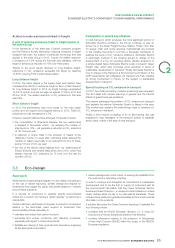APC 2012 Annual Report Download - page 63
Download and view the complete annual report
Please find page 63 of the 2012 APC annual report below. You can navigate through the pages in the report by either clicking on the pages listed below, or by using the keyword search tool below to find specific information within the annual report.
2012 REGISTRATION DOCUMENT SCHNEIDER ELECTRIC 61
SUSTAINABLE DEVELOPMENT
2
SCHNEIDER ELECTRIC’S COMMITMENT TO ENVIRONMENTAL PERFORMANCE
•to roll out energy effi ciency monitoring solutions to sites larger
than 5,000m² and to several strategic sites (i.e., a total of more
than 300) covering 90% of the Group’s total consumption, and
reduce the energy consumption at these sites by 10% in three
years (Energy Action program);
•limit leaks of SF6 to 0.95% of the consumption of that gas on
those sites;
•reduce the emissions associated with transportation paid by the
Group by 10%;
•reduce the Group’s water consumption with specifi c objectives
and action plans for the sites with the highest water consumption
and those located in areas of water stress, and control the
deviations (+/-10%) of all sites that report water consumption;
•monitor VOC emissions (Volatile Organic Compounds) for all
ISO14001 sites holding emissions permits or emitting more than
one ton per year;
•achieve an 85% waste recycling rate;
•achieve 75% of product revenue from products that have a life-
cycle analysis and controlled and limited chemical substance
usage (Green Premium).
For this section, three key performance indicators were set in the Planet&Society Barometer for the duration of the Connect program
(2012-2014):
Objectives for year end 2014 2012 2011
1. 10% CO2 savings on transportation 14.8% ▲-
2. 75% of our product revenues achieved with Green Premium 65.5% ▲63%
3. 10% energy consumption savings 6.1% ▲-
The 2011 performance serves as a starting value for the Planet&Society Barometer Connect program between 2012 and 2014.
▲ 2012 Audited Indicators.
Please refer to pages 92 to 94 for the methodological presentation of indicators and the following pages for the analysis of the results (pages
65 for indicator1, 65-67 for indicator2 and 63-64 for indicator3).
Organization
At the corporate level, S ustainable D evelopment Department
establishes the Group’s environmental strategy and leads the
corporate environmental players, jointly with the Global Supply
Chain Management. The Sustainable Development Director
is ranked below the Executive Vice President of Strategy and
Innovation (member of the Group’s Executive Committee).
The Environment Director, ranked below the Senior Vice President
of the Global Supply Chain Management (member of the Group’s
Executive Committee), defi nes and rolls out the environmental
policies and programs; he reports the results and leads the
environmental manager network comprising:
•for product management: environmental managers in each
business who are responsible for integrating environmental
concerns in line-up management, environmental representatives
who are responsible for assessing the impact on marketing,
and environmental specialists with expertise in integrating
environmental aspects into product design;
•for site management: environmental managers in each major
region, environmental managers in each large region with
signifi cant business volume, and environmental managers in
each plant or supply chain center.
In2010, the organization within Global Supply Chain Management
changed from a corporate-only leadership to a regional organization
(North America; Asia-Pacifi c; Europe, Middle- East, Africa and
South America). Three SERE (Safety, Environment and Real
Estate) directors were appointed; each one is responsible for
implementing the Group’s policies in these fi elds for all sites within
their geographical area and for reporting on progress plans. There is
a meeting of the three directors every quarter to ensure coherence
in the Security, Environment and Real-Estate policies for the entire
Group. To implement this policy, the SERE directors lead a network
of more than 200 managers responsible for the environmental
management of industrial, logistic and administrative sites.
These networks have access to a wide range of management
and experience sharing resources including directives, application
guides, an intranet site and databases.
The Transport Director, within Global Supply Chain Management,
is in charge of measuring and reducing freight CO2 emissions at
Group level.
To educate all employees on environmental issues, e-learning
modules have been developed, including the eco-responsible
management of energy and environment; these modules
complement the existing technical training. In addition, an Intranet
environment is accessible by all employees and expanded
continuously to inform everyone about the levels of our programs
and the contribution of each one.
Highlights of2012
•Indexation of the performance incentives for the Executive
Committee members to one or more components of the
Planet & Society Barometer, chosen according to their fi eld,
(since 2011); expansion in 2012 to the Country Presidents of
the fi ve principal countries; especially Green Premium for Global
Supply Chain Management and Activities, reductions in CO2,
ISO14001 and energy effi ciency for Global Supply Chain.
•Launch of a new Planet&Society Barometer for the 2012-2014
period: the CO2 emissions reduction indicator for 2009-2011,
whose target of 90,000tons was exceeded, was extended to
























